Deeper into the Baroque: the New York exhibition on Valentin de Boulogne
A young man with black curls falling over his forehead and a half-closed mouth sits pensively in the shadows, his lost gaze turned to the left of the painting. He wears a flake armor of deep blue and is wrapped in a rich crimson tunic. His right arm, with which he holds his head, rests on a lion skin on which a donkey jaw also lies. The sole protagonist of the painting is Samson, biblical hero and perpetrator of the slaughter of hundreds of Philistines, perpetrated with the use of only the donkey jaw and its boundless strength. Before the slaughter and a series of events that would lead to his untimely death, Samson had killed a lion with his bare hands, in whose mouth bees would later form their own hive and produce honey. Bees, though dimly visible, are also depicted in the painting, on the left below, and in addition to alluding to the hero’s other exploits, they play an exquisitely laudatory role. Three bees stood out, in fact, in the coat of arms of the Barberini, the family of Tuscan origin that would compete with other European powers in temporal power in Rome in the seventeenth century, thanks to the long papacy of Urban VIII. Two more bees, clearly visible even to the naked eye on the hero’s left shoulder, close its armor, making the work’s connection to its patron even more manifest. Its author, “painter Valentinus,” certainly guided by learned literati, thus gave his own particular interpretation of one of the best-known and most abused biblical subjects, turning it into an occasion for Barberinian celebration. Let us start from the beginning, however.
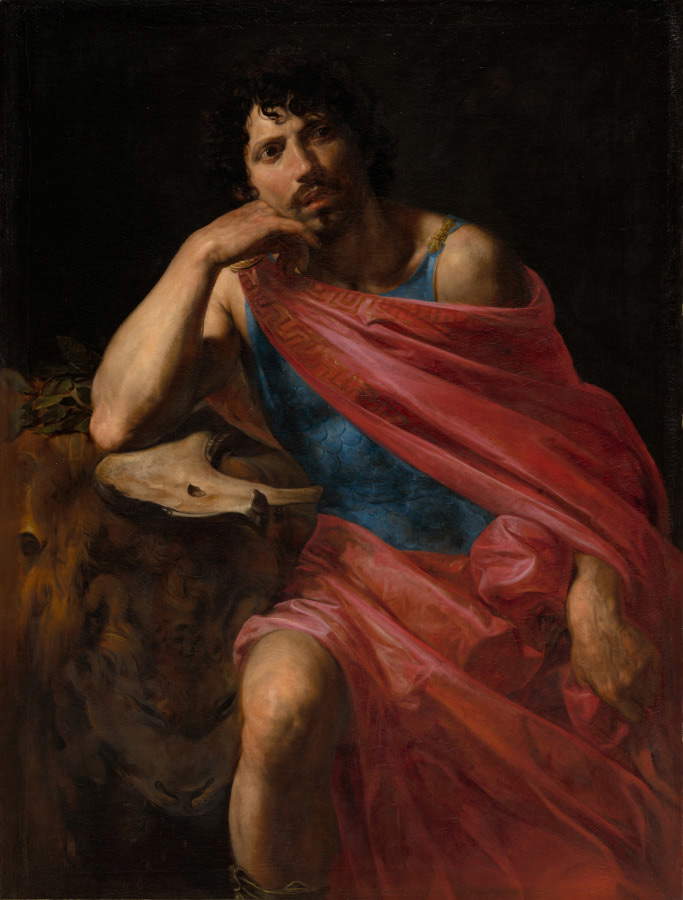 |
| Valentin de Boulogne, Samson (ca. 1630; oil on canvas, 157 x 125 cm; Cleveland, The Cleveland Museum of Art) |
The exhibition Valentin de Boulogne: Beyond Caravaggio, housed on the second floor of the Metropolitan Museum of Art in New York, is the first to focus on the French Caravaggesque painter. The exhibition examines his entire oeuvre: from his beginnings close to Cecco del Caravaggio and Bartolomeo Manfredi to his masterpieces for the Barberini family between the late 1620s and his death in 1632. The MET exhibits three-quarters of the approximately sixty works attributed to the artist, and those on display include all six canvases from the Louvre, which will host the same exhibition from the end of February until August next year.
The exhibition is the brainchild of Keith Christiansen, chief curator of the MET’s department of European painting, and Annick Lemoine, maître de conférences at the University of Rennes, and betrays a layered knowledge of the painter’s biographical and artistic events. Indeed, the review’s link to an exhibition “first installment,” namely the exhibition I bassifondi del Barocco, curated by Francesca Cappelletti and Lemoine herself, held in Rome at the Academy of France, is evident. The New York exhibition (and so then its Parisian leg) represents a monographic deepening of the previous one calibrated on a foreign painter who was among the first to assimilate and, simultaneously, transform Caravaggism.
Valentin de Boulogne was born in Coulommiers, near Paris in 1591. Little is known of his beginnings in France, where he likely learned the first rudiments of painting in his father’s workshop. By 1612 he was certainly in Rome, where, as Baldinucci wrote, “he imitated Caravaggio very much, to whom he was very similar in the genius of representing in his canvases sounds, jousts, gypsies, and the like.” It is precisely this kind of humanity that recurs in Valentin’s large, rectangular-format paintings: gypsies reading hands to patrons promptly robbed, naïve card players gulled thanks to the complicity of cheats behind their backs, or, again, small groups of concertgoers gathered around tavern tables or carved marble blocks. Thanks to the perusal of the States of Souls, registers with which Roman parishes counted their more or less practicing faithful, it was possible to trace the places where Valentin lived during his Roman years. In fact, between Via del Babuino and Via Margutta, in the area between the churches of Santa Maria del Popolo and Trinità dei Monti, many foreign painters, especially French (and among them Valentin), Flemish and Dutch, were concentrated in the first decades of the seventeenth century. The latter gave rise to a new, cheerful form of association, far removed from the “congealed” Accademia di San Luca, an institution that stood as guarantor of painters’ rights in exchange for a membership fee. The Bentvogels, the “birds of a flock,” as they decided to call themselves, were instead mostly young painters given to revelry and excess, their meetings were very unofficial, and access to their guild was through special initiations somewhere between paganism and sheer waffling. They included Gerrit van Honthorst, also known as Gherardo delle Notti, Dirck van Baburen, and, of course, our own Valentin who, though French, entered the Bent in 1624 under the name “Amador,” the Lover. Two years later, his first encounter with the Academy of St. Luke took place, when, certainly through the mediation of the Classicist painters Simon Vouet and Nicolas Poussin, he turns out to be the organizer of the feast of the patron saint of painters. From the same year, commissions for Cardinal Francesco Barberini and the papal family began for him. It was thanks to the prelate’s interest that Valentin produced two of his masterpieces: theAllegory of Italy, preserved today at the Finnish Institute in Rome, and a grandiose altarpiece for St. Peter’s with the Martyrdom of Saints Processo and Martiniano.
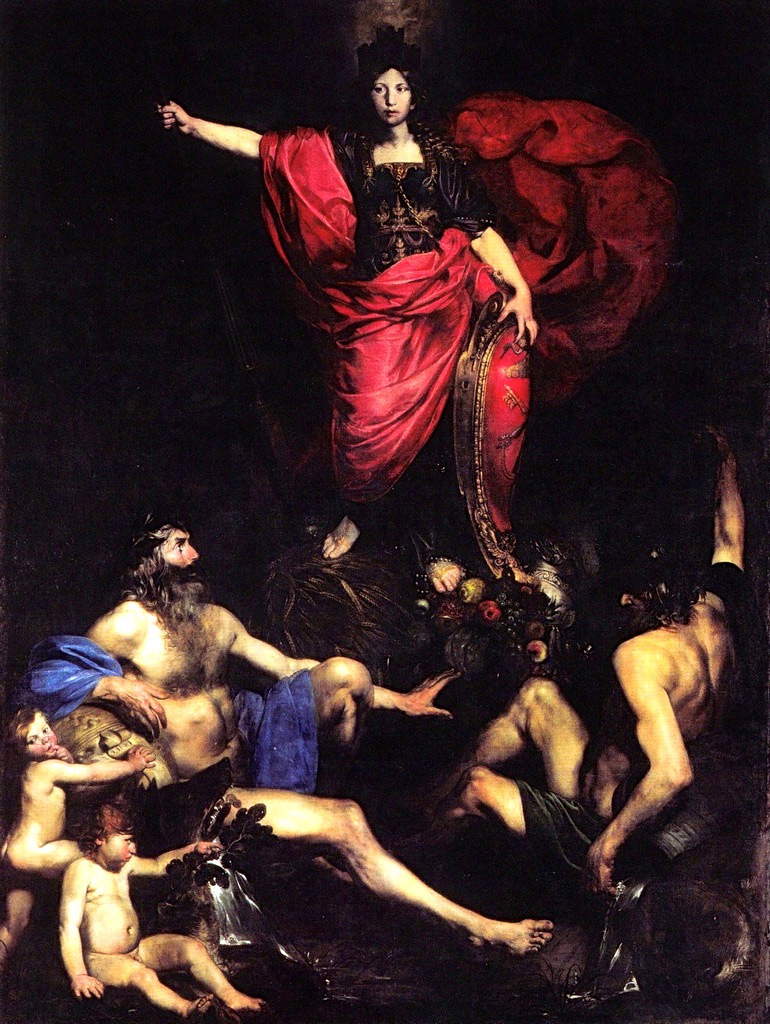 |
| Valentin de Boulogne, Allegory of Italy (1627-1628; oil on canvas, 345 x 333 cm; Rome, Institutum Romanum Finlandiae, Villa Lante on the Janiculum Hill) |
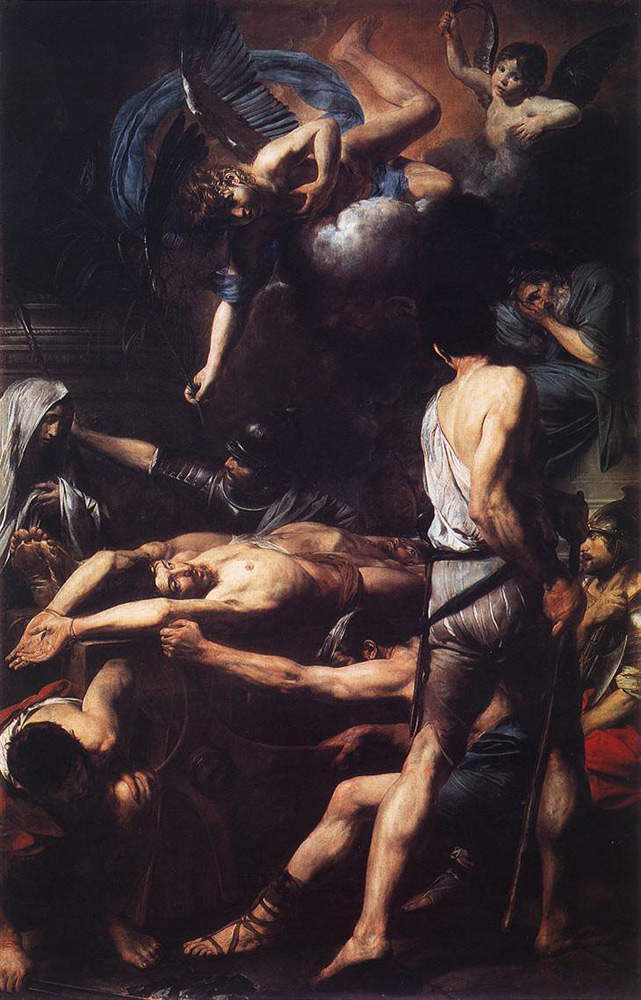 |
| Valentin de Boulogne, Martyrdom of Saints Processo and Martinian (1629; oil on canvas, 302 x 192 cm; Rome, Vatican City, Pinacoteca Vaticana) |
The cut of the exhibition is strictly monographic: with the exception of three works by Manfredi, Cecco del Caravaggio and Ribera in the opening, only works by the painter from Coulommiers are on display. Their subjects are predominantly complex and sometimes messy tavern scenes with palm readings, card games and concerts, but there is no shortage of biblical subjects such as the Judgment of Solomon (in two very similar versions), theInnocence of Susanna and Christ and the Adulteress. Alongside some of these, such as the David with the Head of Goliath from the Thyssen-Bornemisza Museum in Madrid, are expertly juxtaposed swords from the MET’s rich collections with which the painted weapons can be usefully compared. There are numerous paintings depicting a single figure from the knees up: Moses, Samson, and Judith with the head of Holofernes, for example, but also actual portraits of figures gravitating around the Barberini, including, perhaps, a self-portrait as a Lute Player. Among the martyrs, that of Saint Sebastian, made in his younger years, shows Ribera’s influence strongly, while that of Saint Lawrence, more narrative and horizontal in format, is an interesting attempt to give more fluidity to Caravaggio’s naturalism. As anticipated, however, it is the works that close the exhibition, made for or thanks to the Barberini family, that represent the pinnacle of Valentinian production. Although the lighting does not facilitate their optimal enjoyment, the exhibition is a unique opportunity to see together theAllegory and the altarpiece for St. Peter’s, which were born one after the other. In 1963, Francis Haskell was particularly critical of the former, which he called “an awkward attempt to use his Caravaggesque manner on an essentially unsuitable theme” (“an awkward attempt to apply the Caravaggesque manner to an essentially unsuitable theme”), and certainly nothing like it had ever before been done by a Caravaggesque painter. Again, Barberinian bees flutter within the painting, above the trunk on the left, making the patron and the object of the artist’s adulation even more manifest. Finally, the martyrdom of the two saint-commons Processo and Martiniano represents the high point of the Valentinian parable. As Roberto Longhi recognized in 1943, Valentin succeeded where Caravaggio had failed: after the rejection of the Pala dei Palafrenieri in 1605, a Caravaggesque altarpiece imposed itself on the altar of the most important church in Christendom, unafraid of and, indeed, soliciting comparison with the Martyrdom of St. Erasmus by the classicist Poussin. Valentin’s death in 1632 from a fever brought on by a nighttime bath in a fountain in Rome ended the output of this “pre-romantic” artist who could still have said much through his paintings.
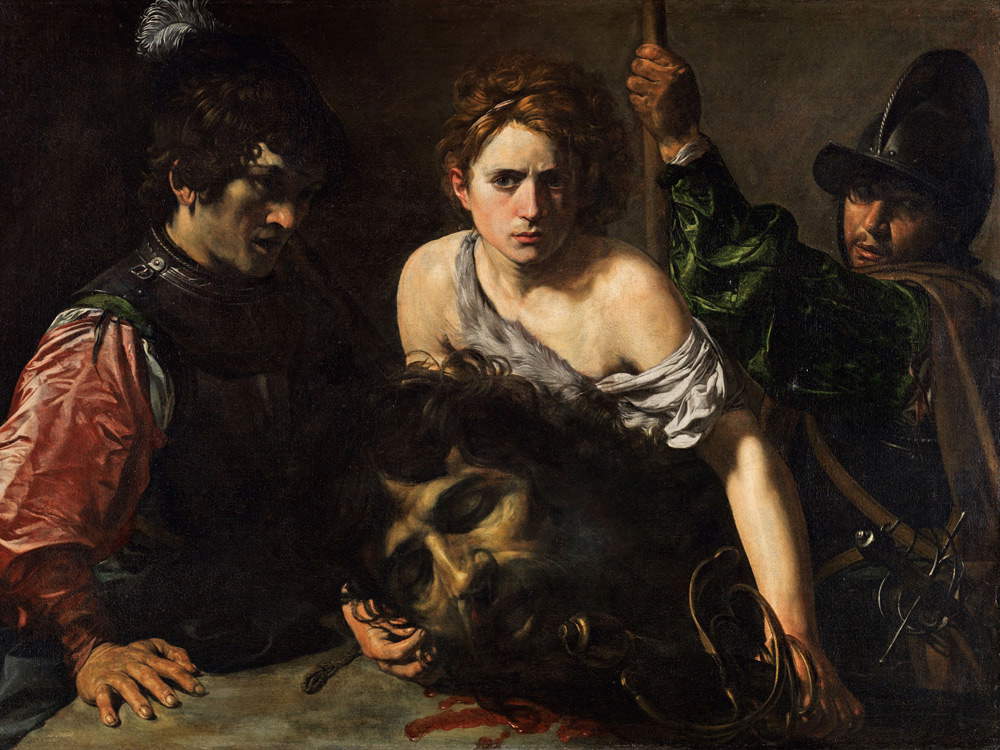 |
| Valentin de Boulogne, David with the Head of Goliath (c. 1620-1622; oil on canvas, 99 x 134 cm; Madrid, Museo Thyssen-Bornemisza) |
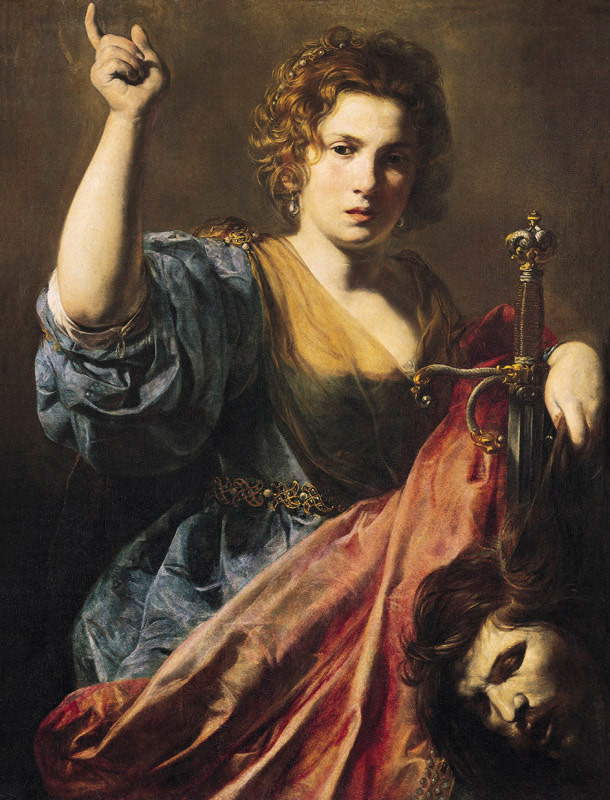 |
| Valentin de Boulogne, Judith with the Head of Holofernes (c. 1625; oil on canvas, 97 x 74 cm; Toulouse, Musée des Augustines) |
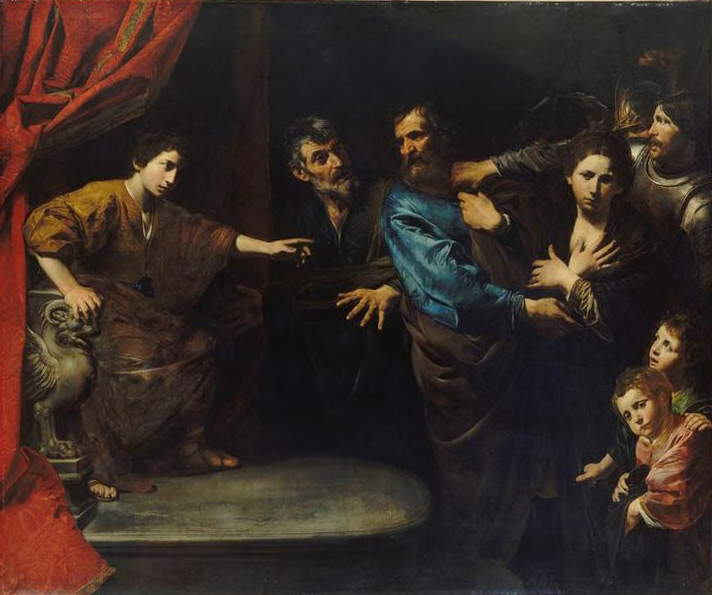 |
| Valentin de Boulogne, The Innocence of Susanna (1625; oil on canvas, 175 x 211 cm; Paris, Louvre) |
The exhibition is not among the easiest. It is evident from the inclusion of “Caravaggio” in its title that its curators wanted to appeal to the general public and those who already know and appreciate Merisi’s work. Such a purpose is certainly not to be condemned; yet, the link stated in the title of the exhibition does not find within the exhibition itself all the feedback one would expect. Valentin’s style, in fact, made up of studies, casts and reinterpretations from Caravaggio’s work, but also modulated on his own ambitions and born in the same environments, is at times debased, so much so that it sometimes appears to be a superficial imitation and trivialization of that of the Lombard master. A reference to Caravaggio’s Denial of St. Peter, a few rooms away from those in the exhibition, or to the Vocation of St. Matthew from the Contarelli Chapel, forerunner of all Valentin’s tavern scenes, would certainly have benefited the New York show, which instead wanted to maintain a strictly monographic slant.
The idea of an exhibition with the works of a single painter, whose corresponding catalog is intended to be an exhaustive essay of his production, clashes with the need for comparisons with what painters contemporary with him were achieving: in Valentin’s case, whether they were Caravaggesque or not. The long sequence of tavern scenes, although each one differs to some extent from the previous and the next, tires the average visitor who would perhaps have preferred a greater variety in the juxtapositions, even at the cost of “breaking down” well-defined thematic units. The Slums of the Baroque, while presenting works of varying quality, but taking advantage of the variety of painters involved and the heterogeneity of the settings of the Academy of France, the exhibition’s Roman venue, really succeeded in bringing to life the Rome of the early decades of the 17th century; conversely, Valentin de Boulogne: Beyond Caravaggio, although scientifically more mature, fails to capture as much as its predecessor.
Warning: the translation into English of the original Italian article was created using automatic tools. We undertake to review all articles, but we do not guarantee the total absence of inaccuracies in the translation due to the program. You can find the original by clicking on the ITA button. If you find any mistake,please contact us.





























